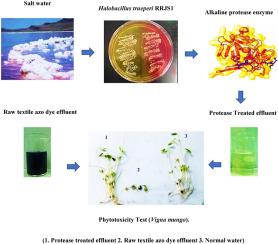Biodegradation and phytotoxicity evaluation of textile azo dye effluent using alkaline protease enzyme from halophilic bacterium Halobacillus trueperi RRJS1
IF 3.4
4区 化学
Q2 CHEMISTRY, MULTIDISCIPLINARY
引用次数: 0
Abstract
Halophiles are salt loving bacteria and they are capable of producing extracellular enzymes. Nowadays, these enzymes are utilized as one of the main ingredients by the industries for manufacturing products and some environmental researchers exploit it for biodegradation studies. The present study highlights the unique biodegradation potential of Halobacillus trueperi RRJS1, a halophilic bacterium capable of producing highly active alkaline protease enzyme. It can withstand high salinity and can survive osmotic stress in the extreme salt concentration. Generally, halophiles produce more extracellular enzymes in high salt concentrations which are generally called as halozymes. Halophiles are salt loving bacteria that thrive in salt lakes and they are competent to produce more extracellular enzymes. These enzymes remain stable under these conditions. In the present research, the halophilic bacteria H. trueperi RRJS1 is screened for production of alkaline protease enzyme and it was used for the degradation of highly toxic ingredients found in the textile azo dye effluent. The bacterial strain H. trueperi RRJS1 was optimized with various physico - chemical parameters and maximum production of the alkaline protease enzyme was recorded at 40 °C and pH 7.5 (99.23 ± 0.42 U/ml); and in 6 % NaCl concentration (60.5 ± 1.28 U/ml). Among the nutritional sources, 1 % lactose and 1 % beef extract were induced maximum production of alkaline protease (24.7 ± 0.8 U/ml and 59.1 ± 0.56 U/ml). The physico-chemical parameters such as pH, BOD, COD, TDS, total hardness and chlorides were efficiently checked in the alkaline protease enzyme treated textile azo dye effluent. Degradation of textile azo-dye effluent by alkaline protease enzyme was conducted and highest percentage of degradation (84.30 %) was observed at alkaline protease enzyme produced by lactose. The GC-MS analysis of the alkaline protease treated textile azo dye effluent exhibited the presence of major and minor chemical compounds, and they were responsible for the degradation of azo dye components and 100 % disappearance of compounds in raw textile azo dye effluent was observed. The phytotoxicity studies on black gram Vigna mungo revealed that the plants grown on the alkaline protease treated textile azo dye effluent enhanced seed germination (80 %), plumule (8.7 ± 1.35 cm) and radicle length (3.5 ± 1.80 cm) and less growth were observed in the raw textile azo dye effluent treated plants. The textile azo-dye effluent often encompassed with high concentration of salt and it could inhibit growth of the most microbial organisms in the polluted textile water. But, in this study, the extracellular protease enzyme from the halophilic bacteria H. truperi RRJS1 exhibited reliable performance for the degradation of textile azo-dye effluent. This eco-friendly strain could effectively support sustainable textile waste water treatment strategies and remove the contaminants in the highly polluted textile azo-dye effluent.

利用嗜盐细菌真盐杆菌RRJS1碱性蛋白酶降解纺织偶氮染料废水及植物毒性评价
嗜盐菌是嗜盐细菌,它们能够产生细胞外酶。目前,这些酶被用作工业生产产品的主要成分之一,一些环境研究人员利用它进行生物降解研究。本研究强调了真盐杆菌RRJS1独特的生物降解潜力,这是一种能够产生高活性碱性蛋白酶的嗜盐细菌。它可以承受高盐度,并能在极端盐浓度下生存渗透胁迫。一般来说,嗜盐菌在高盐浓度下产生更多的细胞外酶,这些酶通常被称为盐酶。嗜盐菌是在盐湖中繁殖的嗜盐细菌,它们有能力产生更多的细胞外酶。这些酶在这些条件下保持稳定。在本研究中,筛选了嗜盐细菌H. trueperi RRJS1,用于生产碱性蛋白酶,并将其用于降解纺织偶氮染料废水中的剧毒成分。采用多种理化参数对菌株trueperi RRJS1进行了优化,在40℃、pH 7.5(99.23±0.42 U/ml)条件下碱性蛋白酶酶的产量最高;6% NaCl浓度(60.5±1.28 U/ml)。在营养来源中,1%乳糖和1%牛肉提取物诱导的碱性蛋白酶产量最高,分别为24.7±0.8 U/ml和59.1±0.56 U/ml。对碱性蛋白酶处理的纺织偶氮染料出水的pH、BOD、COD、TDS、总硬度和氯化物等理化参数进行了检测。用碱性蛋白酶对纺织偶氮染料废水进行了降解,以乳糖为原料的碱性蛋白酶对纺织偶氮染料废水的降解率最高,达到84.30%。对碱性蛋白酶处理后的纺织偶氮染料出水进行气相色谱-质谱分析,发现主要化合物和次要化合物是偶氮染料组分降解的主要原因,在纺织偶氮染料原液中化合物100%消失。结果表明,在碱性蛋白酶处理的纺织偶氮染料废水上生长的黑克(Vigna mungo)植物种子萌发率提高了80%,胚珠长(8.7±1.35 cm),胚根长(3.5±1.80 cm)增加,而在纺织偶氮染料废水上生长的植物生长速度减慢。纺织偶氮染料废水中含有高浓度的盐,它能抑制污染的纺织废水中大部分微生物的生长。但是,在本研究中,嗜盐细菌H. truperi RRJS1的胞外蛋白酶在降解纺织偶氮染料废水中表现出可靠的性能。这种环保型菌株可以有效地支持可持续的纺织废水处理策略,并去除高度污染的纺织偶氮染料废水中的污染物。
本文章由计算机程序翻译,如有差异,请以英文原文为准。
求助全文
约1分钟内获得全文
求助全文
来源期刊
CiteScore
3.50
自引率
7.70%
发文量
492
审稿时长
3-8 weeks
期刊介绍:
The Journal of the Indian Chemical Society publishes original, fundamental, theorical, experimental research work of highest quality in all areas of chemistry, biochemistry, medicinal chemistry, electrochemistry, agrochemistry, chemical engineering and technology, food chemistry, environmental chemistry, etc.

 求助内容:
求助内容: 应助结果提醒方式:
应助结果提醒方式:


